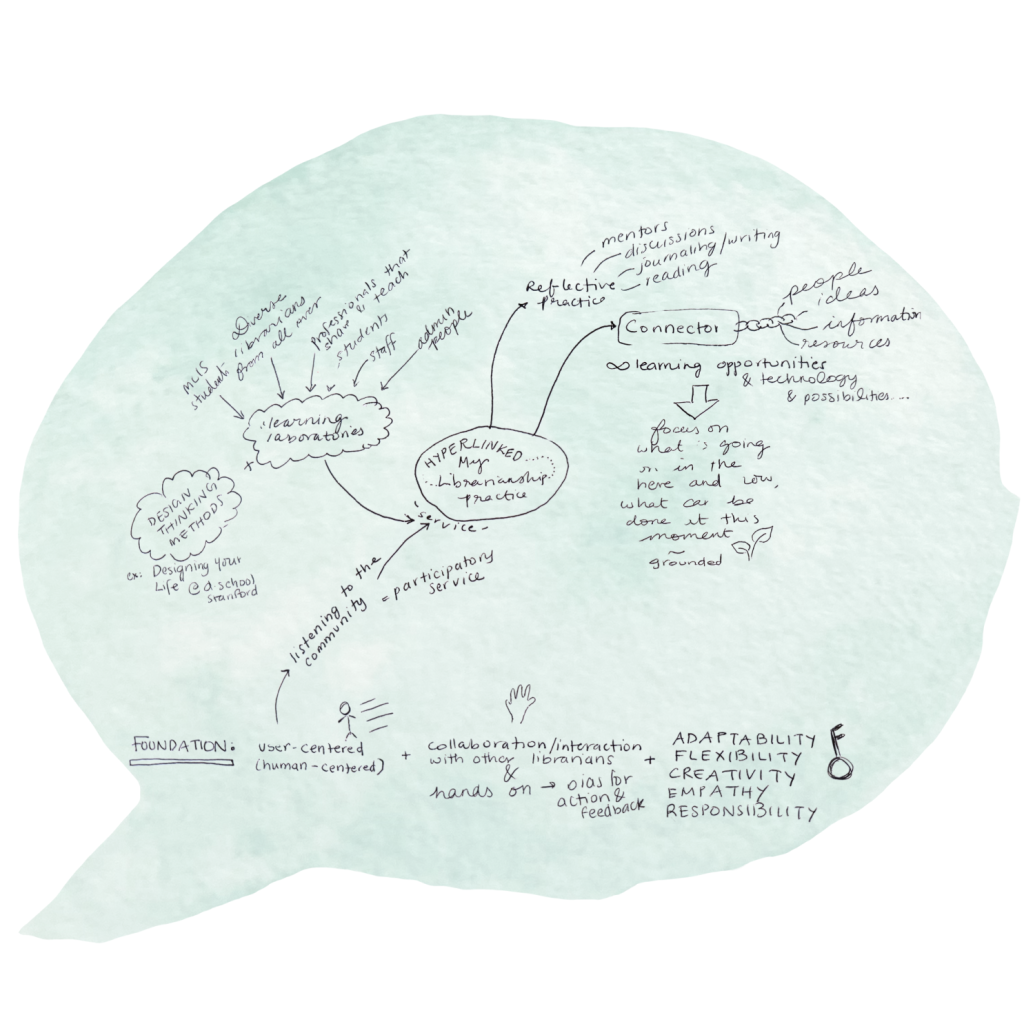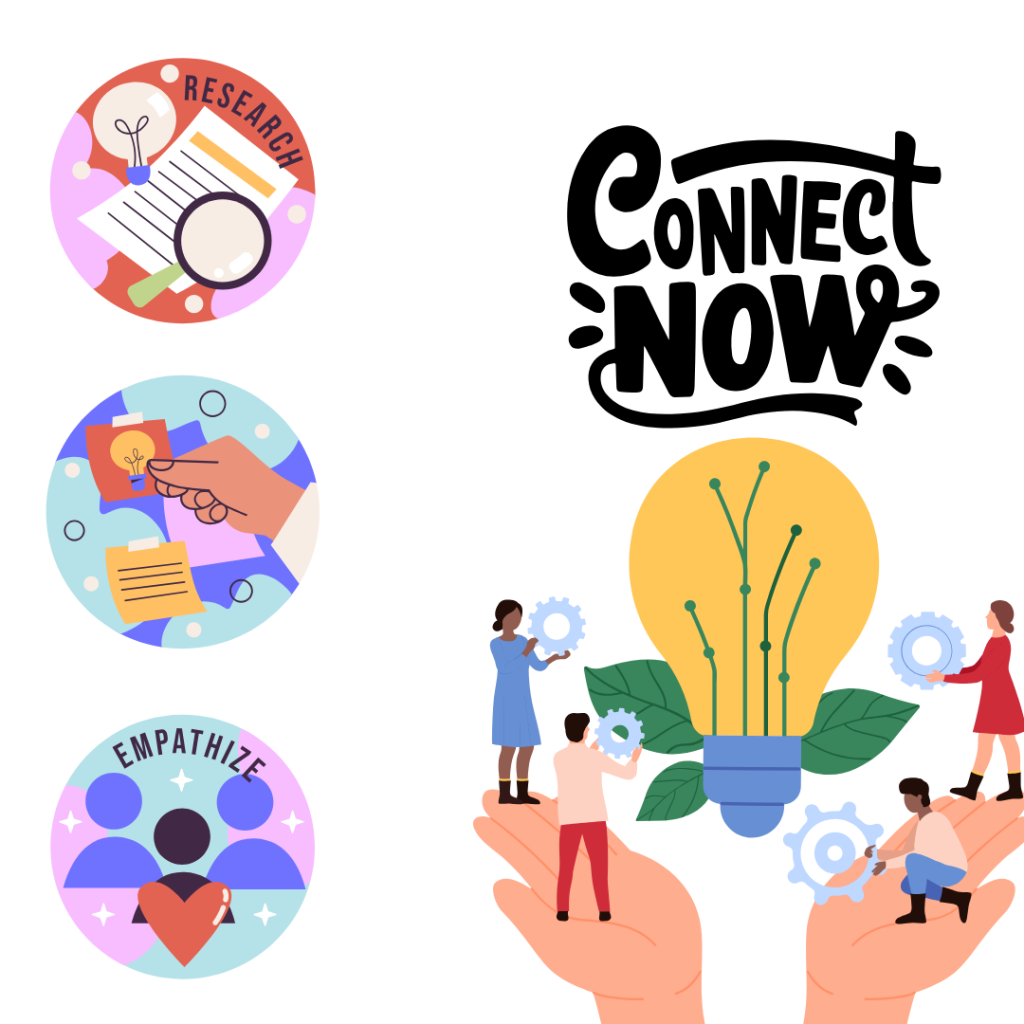Where to start?
As I reflect on the kind of librarian I’m becoming, two concepts stand out: people-centered service and the idea of the library as a learning laboratory to create positive change. These concepts reinforce the idea of libraries and librarians as connectors. We, along with the space that we work in, serve to connect people to resources, services, ideas, and to each other.
People (or user) centered thinking
When I first started working in libraries, I was interested in user-experience design but disliked the idea of working in tech. Instead, what drew me in was the chance to help people access resources that they really wanted, or didn’t know they needed, in order to enrich and uplift their life. When I thought about having empathy, I thought about affordability, access, community, and safe spaces.
At work, I considered:
How do people navigate the building? Can they find what they’re looking for easily? Are they having a good experience discovering things or are they frustrated? How can I respond to a patron who’s overwhelmed, impatient, or uncertain?
My experience so far
Right now, I work for both the San Jose Public Library and the Santa Clara County Library District.
This has been an eye-opening and interesting experience. Having experience in both systems has helped me better serve patrons, but there are differences between the two as well. For example, the County’s libraries are more community-oriented and flexible, and the librarians have more autonomy. If a patron wants to suggest an item for purchase, they can do it on their Bibliocommons account and they are able to track it and see if it was approved or not approved for purchase. I think this adds to the diversity of the collection, and collection development becomes more of a participatory service this way.
The City’s branches stem from a more centralized system, with a marketing team of staff who are not librarians and, programming comes from the main branch and the librarians have little room for creative, customized to the community kind of programs.
Learning Laboratories
In the first chapter of The Heart of Librarianship, the idea of creating learning library laboratories (which also excited the scientist in me) caught my attention:
“... Professors, librarians, and students must work together to create new models of service and outreach. These models are evaluated and tweaked, and effective practice is reported to the greater community”
I can imagine a space where things are designed and tested with real people, feedback is welcomed and encouraged, and the library is community-centered and adaptive, and the best part is that library staff can take what is learned in such a lab and implement it in their libraries. The shift from rigid top-down flow of how things “should” work to a sort of iterative and people centered flexibility is very inspiring. This reminded me of the “People and the UTS Library” article and their mention of design thinking and learning by doing, experimenting, and play (which is also emphasized at the County library where I work!). A culture of shared responsibility for change, testing ideas, learning opportunities, and staff empowered and trusted to contribute to shaping a new model of service can benefit not just the people that come, but serves as a model for positive change in other libraries as well.
Questions, Reflections, and Looking Ahead
I step into taking responsibility within my library community, and with each experience, I will be employing reflective practice. When people ask me what librarians do, I am going to create an elevator pitch not just for me, but for advocating for libraries and librarianship as a whole.
Starting in a new field and working in an already established system with coworkers that are 15, 20 years into their profession, I find where reality and idealized thinking clash, but because of the many examples of librarians and libraries leading change, I feel I have solid evidence that positive change is possible with as I take responsibility in my librarianship practice.
With my new emphasis on reflective practice, with a focus on the people that I serve, and a bias to act on new ideas through small steps, I now have new questions for my practice:
How can we reach people that do not come into the library? Where and why do I seek permission? Where can I take small actions backed up by evidence, listen to staff and the community to implement positive change? How can I show up intentionally for my community today?
Sources:
Stephens, M. (2016). Chapter 1: “The Hyperlinked Librarian: Skills, Mind-Sets, and Ideas for Working in the Evolving Library” in The Heart of Librarianship: Attentive, Positive, and Purposeful Change
http://287.hyperlib.sjsu.edu/wp-content/uploads/2014/06/Booth_PeopleUTSLibrary.pdf
Here is a mind map that I drew


I love your mind map.
Also, I feel like I ask myself all the questions you are asking in your post. I like that you are taking a reflective approach and using small steps towards new ideas.
Hi Amritha, I also am interested in user-centered thinking. My background is in design and I’ve been searching for the bridge between my past experience and my new career in librarianship. I had a read “aha” moment last semester taking INFO 287 User Experience when I realized that user-centered thinking can be applied to more than just apps/websites but in physical spaces too. Your post reminded me of this “aha” moment. I enjoyed your reflection on People (or user) centered thinking, thanks for sharing!